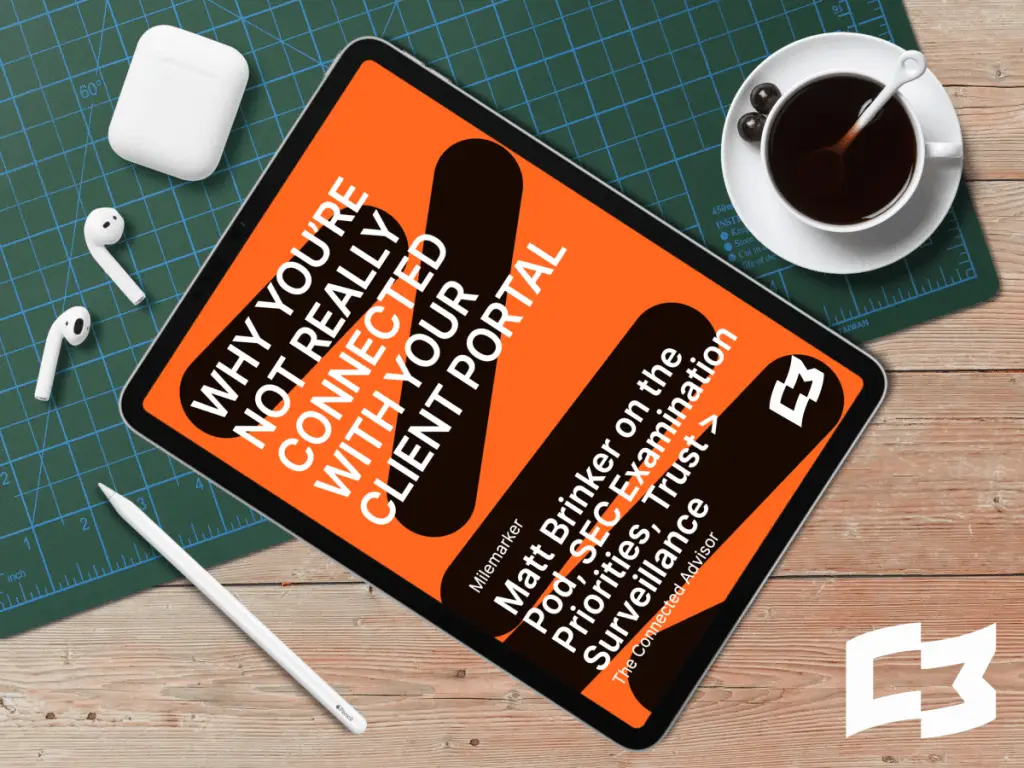Why You’re Not Really Connected with Your Client Portal — And How You Can Fix That

It seems like client portals are a centerpiece in our wealth management landscape. You have a lot of choices on what you want your client to use.
Planning software.
Portfolio accounting software.
Portal-specific software.
Custodial portal.
Snail mail reports or custodial statements.
You have many choices, and all seem to have their shortcomings – at least based on nearly every advisor I talk with.
Not all your clients have a financial plan to find value in using the planning-based portal.
For many of you, your asset allocation is pretty simple, and the rest of the accouterment in your portal leaves a lot to be desired.
Ultimately, your clients need to know that their assets are OK, that you care about them, and that they are on their course to success. Whatever technology you choose and whatever medium you choose to relay this message through is up to you; it just needs to be getting to them somehow.
We know you care about your clients, but now and then, they need reminders too.
Problems with Portals
While no technology is perfect, you need to ensure that your portal does a minimum of two things:
It provides easy access for your clients and gives their CPA all the information that they could need. After all, it is a portal. It should take you somewhere to something and it should work consistently and effortlessly.
It serves as a centerpiece of your relationship with your client. This is one of those “whether you like it or not” sorts of situations. Your portal becomes that place that they can access everything all at once and make a key evaluation.
Does it tell the story you want?
Common Portal Problems
Accessibility Issues
Making your portal as easily accessible for your clients as possible is critically important. Have empathy here, and remember that your clients are not all tech wizards. Consider the age of your clients and how adaptable they are to utilizing new technology.
Think of two-factor authentication. While it does have its cybersecurity and protection merits, it can be highly frustrating for your clients because it’s one more hoop to jump through to get logged in.
Also, is your portal accessible via mobile devices? Fewer and fewer people are owning desktop computers and laptops, opting to rely solely on mobile devices.
Come up with a playbook for how your advisors can get your clients set up effectively during your client meetings.
Lack of Tracking Capabilities
When you meet with your clients, it’s essential to understand what they know going into the meeting. That way, you can tailor the meeting to fit their needs and efficiently use their time (and yours).
So many portals lack simple tracking capabilities that hinder your understanding as an advisor of what your clients have and haven’t seen when it comes to their investments.
If your clients aren’t logging in, you can provide guidance.
If your clients log in frequently, they may be evaluating your relationship – in which case you need prompts to reach out and call.
Failure to Tell the Story of the Relationship
Showing asset allocation and balances is table stakes. If your client’s kids were to see their parent’s portal, would it tell the story of how well you serve your clients?
eMoney and others have begun to add quality data points that help to demonstrate the value of the relationship between an advisor and client over time. Our team at Milemarker is helping firms unlock this data across all of your clients and help you analyze patterns and truly work with that data.
What story would you want to share across your client relationships?
And that’s just a few issues; the list could go on. Currently, the bar is set lower than it should be for client portal technologies.
Tools That Are Useful to Me
While there are significant gaps in where we want to be and where we are with technology, there are ways to get there. Here are a few tools I found that are a cut above the rest.
This tool has been handy over the last few months as my family is navigating the loss of my father. The team at Trustworthy has done an excellent job at solving the information gap around your estate and giving your family a centralized place to access all information. It doesn’t necessarily do account aggregation, but it’s more of life aggregation and has a recent version for advisors.
When I ask financial professionals which platform they use for their planning, I often hear Personal Capital. While the company has evolved since joining Empower, the technology remains sound.
Some of the critical aspects of Personal Capital’s software that stand out to me are the centrality of your net worth calculation, the ease of using simple retirement calculators, how smoothly the system detects a change in accounts, and how it triggers workflows for real-life advisors to call and offer help.
These things should be happening in portal software today but, sadly, are less common.
In the end, whatever technologies we choose to use, the most crucial part is making our firms and our client’s experience better. Make sure that the technologies you choose align with your values as a firm and reflect the client experience you want to deliver to your clients.
A Mammoth Example
The team over at Mammoth Technology is an excellent example of utilizing technology to own all aspects of the client experience. Milemarker worked with Mammoth to create a platform that connects private investments for advisors, fund managers, and investors.
They recognized the need for a unified platform rather than relying solely on their fund administrator.
Milemarker worked with Mammoth Technology to create a customized private investing experience that consolidates business, fund, investment commentary, and investor relations information in one place. The platform gives clients a centralized investment hub, including K1s and other pertinent information.
Through the portal, advisors can aggregate data across clients and seamlessly integrate it into the platform. Mammoth prioritized providing advisors with early insights from investor relations teams, enabling them to lead conversations with investors rather than vice versa.
The platform acts as a tangible reflection of Mammoth Technology’s client experience.
Action Steps
As we think about portals, here are the steps I recommend to you as you make your evaluation.
Make a list of what actually matters to your clients.
Map out what tells the story of your relationship with your clients.
Develop a plan for how you want to bring all these factors together under one roof.
Define the interactions your clients need from you as their advisor, understanding that 80% of a client portal is just the interactions around your data.
So, get out your Sharpies and start putting the pieces together on paper to see what stands out to you.
I’d love to hear from you on what pieces you find most important when getting the most out of your portal. Feel free to respond to this email and let’s have a conversation.
